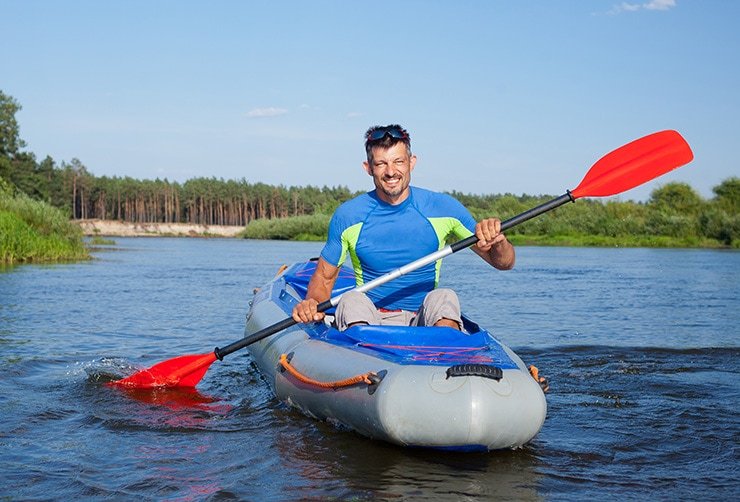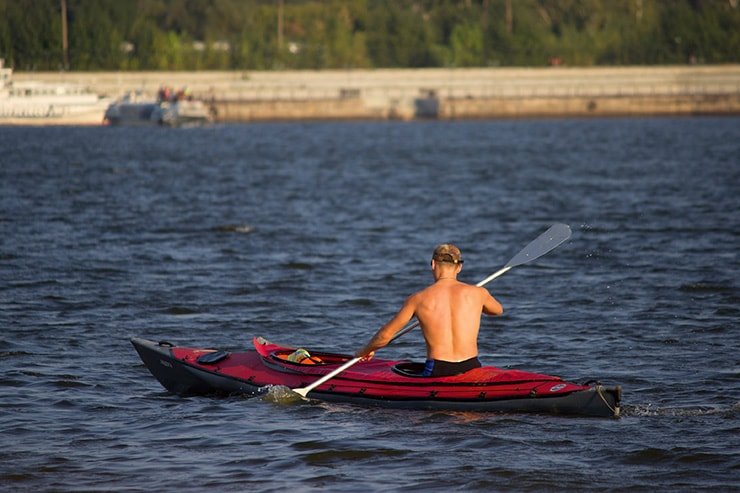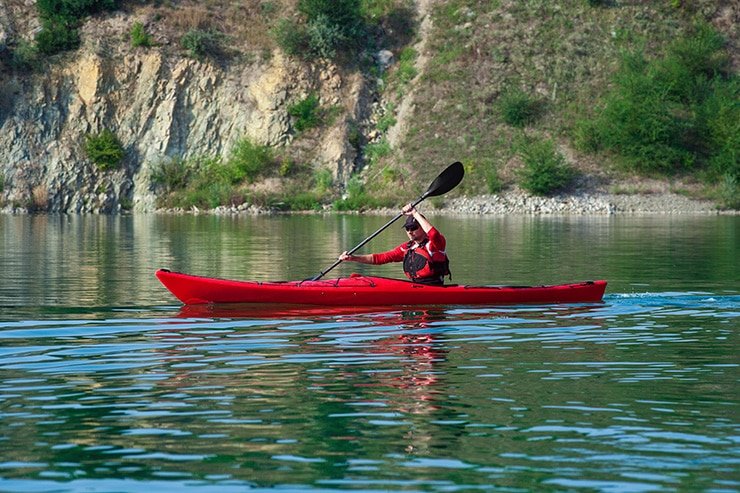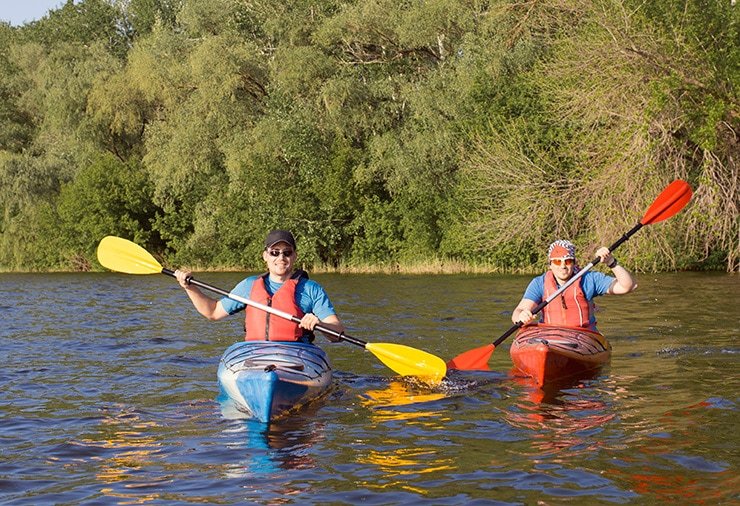Kayaking is a fantastic way to develop your fitness. It’s also a great activity that can scale to both beginners and experts alike!
Having a clear understanding of what muscles kayaking works and what it does for your overall fitness helps you get the biggest bang for your buck out of this physical activity.
Kayaking is quite a unique activity, it benefits nearly every fitness marker you can think of but it also does it without wearing the body down. This article will serve as a complete guide to answer the question – what muscles does kayaking work?
Key Takeaways
- Kayaking is a full-body workout that works most of the major muscle groups in the body, while also challenging the cardiovascular system and being easy on the joints.
- It can help burn calories, tone muscles, and improve fitness without causing excessive stress or injury to the body.
- Kayaking can also build muscle and tone your body, but it depends on the intensity of the activity, your fitness level, and your diet.
- Kayaking is a fun activity that can be enjoyed by beginners and experts alike, and it also offers mental benefits from being outdoors and in nature.
What Type of Exercise Is Kayaking?
Kayaking is considered cardio exercise, but it also strengthens certain muscle groups that promote an athletic-looking physique (if you doubt this, look at the upper body of a competitive kayaker).
Kayaking is great for the lungs and heart but it also offers a host of comprehensive benefits that work the body as an integrated unit. Kayaking improves your fitness without bashing you up in the process and can be good for the health of your joints.
What Muscle Groups Does Kayaking Work?
Kayaking is a great full body workout. It works multiple muscle groups, which makes kayaking good exercise for anyone looking to burn calories and build strength and endurance. Kayaking works the following muscles:
- Biceps
- Triceps
- Core muscles (abdominal muscles and obliques)
- Shoulder muscles and the rotator cuff (deltoids)
- Latissimus dorsi (mid back)
- Rhomboid muscles (the big muscles in the back)
- Quadriceps, and hamstrings (leg muscles)
- Glutes (bum muscles)
- Calves
Your legs play a vital role in generating power – if you’ve ever watched competitive kayakers you might have seen them pump their legs almost like they’re pressing on pedals. The muscles of the legs can generate enormous amounts of power and you might notice yourself doing this when the water conditions get more challenging.
As you can see, kayaking is good exercise for nearly every single major muscle group in the body. It’s better to say, what muscles doesn’t kayaking work? The pectoral muscles (chest muscles) get the least work of every other muscle group but are still used in the rowing motion that most kayakers use.
Practically all of the major muscles of the upper and lower body are used when kayaking, it’s a full-body workout with great health benefits to boot.

What Arm Muscles Are Used in Kayaking?
While we’ve listed the muscles that kayaking works, it’s worth taking a closer look at the different groups. Everything from your fingers to your shoulder blades is used when you’re kayaking.
The biceps and triceps are used to stabilize and move the paddle and your shoulder blades (powered by the deltoids, lats, and trapezius muscles) also do a lot of heavy lifting.
It’s necessary to look at the body as a whole when looking at how kayaking works muscle – a lot of the major movement comes from subtle rotations in the hips and backs – but both the biceps have got to be in pretty good condition to kayak for long periods in challenging conditions.
Can You Get Toned Biceps From Kayaking?
This depends entirely upon how vigorously you kayak – your muscles respond to the demands imposed upon them through the environment. If your kayaking sessions are challenging then you might find your bicep getting larger and stronger – this is what gives the appearance of a “toned” muscle.
However, if you take it easy and prefer relaxing sessions then you might not see much bicep development. If you’re starting from an already high level of fitness, kayaking is not likely to do much for the appearance of your biceps, but if you’ve not exercised for a while, you might be surprised to see muscles sprouting from your arm after a few weeks or months.
Kayaking is similar to arm pulls (which are known to be a fantastic arm workout), as your entire arm is used through a full range of motion, but you would have to engage in this physical activity over extended periods to start seeing toned biceps.
Kayaking Develops Your Core
Your core (the stomach muscles and the sides of the waist) is also developed by kayaking. The rotational movements in kayaking are great for the core – because they challenge the muscles surrounding your spine to stabilize through different planes of motion (this is what they do all the time, but kayaking adds an additional challenge).
Kayaking regularly will slowly but surely develop your core. These muscles play a vital role in stabilization and the more vigorously you kayak, the harder the abdominals have to work. A strong core is needed to transfer the power generated from the hips and legs across the whole body.
The core is also involved in maintaining proper posture, so any activity that develops it may help prevent back problems in the future.

What Kind of Workout Is Similar To Kayaking?
There are two major types of workouts in most modern fitness programs (there are other components, but these are the big players – cardiovascular exercise and strength training.
Cardiovascular exercise is about developing stamina and improving the function of the heart, lungs, and blood vessels. Strength training is more about training the muscles of the body to be more resilient, handle heavier loads, or generate more power. It can also be about building muscle for cosmetic purposes.
Some activities are similar to swimming in that they exercise all the muscles while also training the heart and lungs.
In many ways, swimming is similar to kayaking. It challenges all the major muscle groups of the body while boosting cardiovascular health. It’s also easier on the joints because you’re moving through water and not getting high amounts of force impacting your joints like you would with jogging.
Kayaking is also good for upper body mobility because you’re training the rear deltoids, upper traps, and some of the large muscles in the back through their full range of motion. The torso rotation used in kayaking is all great for the joints and blood flow – as this kind of movement is not used much in everyday life.
Is Kayaking a Good Workout?
Kayaking is a great workout that works many muscles in the human body. It works everything from the calves, core muscles, and upper body. You can only kayak outdoors and the fresh air has tons of physical and mental benefits.
Kayaking is a good workout for the cardiovascular system, tones nearly every muscle in the body, and can help burn calories to lose weight. The paddle stroke used in kayaking also trains many upper body muscles through their full range of motion, which can translate to better movement in everyday life.
Can I Get in Shape by Kayaking?
Kayaking can help burn calories and tone many muscles – as covered already. This all translates into helping you look better on dry land. You’re certainly going to have firm abs and a more toned/developed upper body if you kayak consistently.
If you’ve not exercised for a long time, kayaking will help you get in shape and develop a healthy-looking and athletic physique.

Can You Get Ripped From Kayaking?
While getting in shape is one thing, getting ripped is something else entirely. The term ripped refers to a very low level of body fat and usually means around 6 – 13 percent in men and 14 – 20 percent in women.
Females carry more body fat than males, this is due to the difference in hormonal profiles (females have more estrogen and males have more testosterone, relatively speaking).
Getting “ripped” or “shredded” isn’t just solely down to activity. If your goal is to have a very low level of body fat then kayaking can help you, but truthfully, the activity isn’t as important as your diet.
Getting to allow enough body fat percentage to be able to see your abs and look ‘shredded’ involves a lot of discipline, training and diet manipulation. While bodybuilders and fitness enthusiasts may all take individual approaches – the simple solution always comes down ensuring you are in a calorie deficit.
However, the emphasis should be mostly diet and not just whatever you’re doing to burn calories.
A decade or so ago the common advice was to just do a lot of cardio to burn fat, but exercise theory has progressed. Doing excessive cardio can cause your body to produce much higher than normal amounts of cortisol – over time this can cause you to eat more in an effort to fuel your activity.
The same rules here apply to kayaking – you can’t kayak your way to 6 percent body fat. You have to pay attention to a lot of other factors like diet, and stress management. There are other factors like genetics and metabolism at play as well – some people just store fat more easily than others.
Can Kayaking Build Muscle?
Kayaking can build muscle but it depends on what base you’re starting from. If you haven’t exercised in years then yes, kayaking will build muscle, as you’re placing demands on your body that it’s not used to.
However, your body will only adapt to build as much muscle as it needs to kayak efficiently. In other words, kayaking isn’t weight training – there’s some resistance involved, but not enough to consistently and progressively overload your muscles (which is how you make them grow).
So, if you’re already in the gym building muscle, kayaking isn’t going to help you build anymore. However, if you’re completely new to exercise you might be pleasantly surprised to see muscles sprouting from where there were none.
Conclusion
Kayaking is a great form of exercise that works most of the major muscle groups in the body, while also challenging the cardiovascular system and also being a bit easier on the joints than other activities.
We hope you enjoyed reading this information, please like, comment or share with anyone you think would also find value in this guide.

